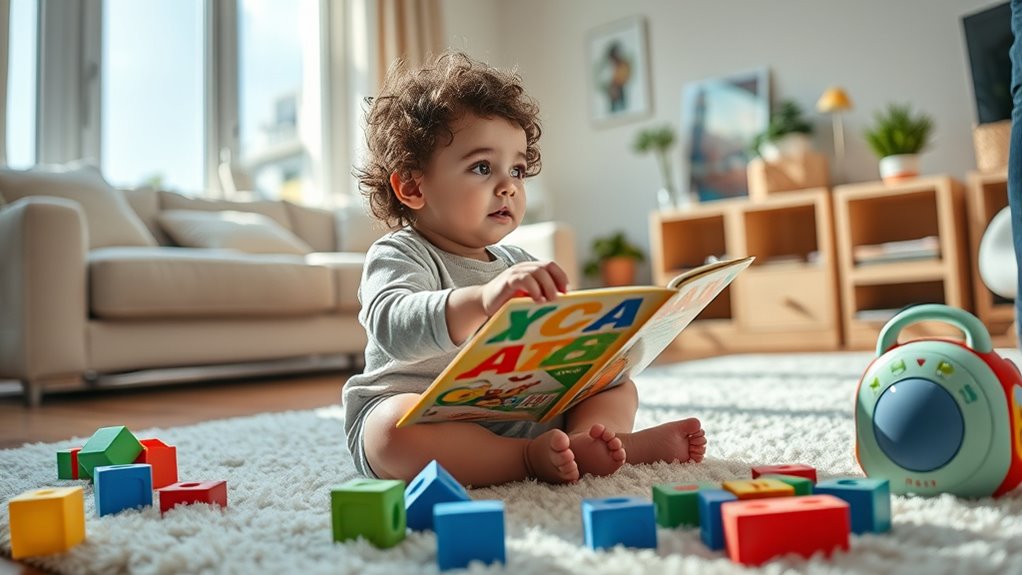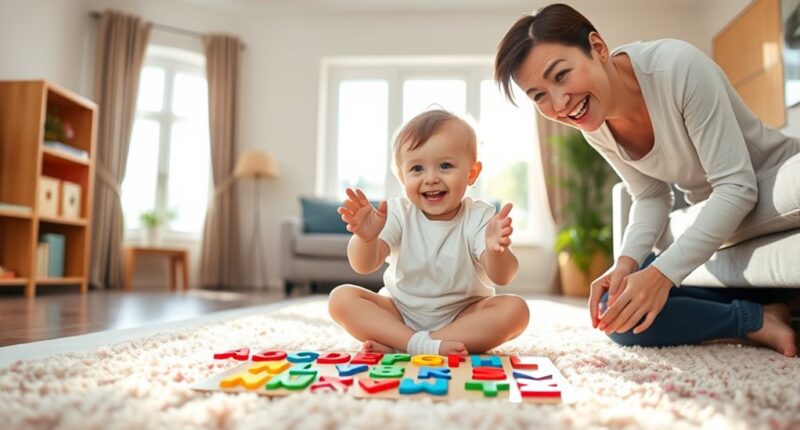To encourage your toddler’s first words during the language explosion, create a rich language environment by talking constantly and describing everyday actions. Use simple signs and gestures alongside spoken words to boost understanding and engagement. Model clear, consistent language and repeat words often. Turn daily routines into fun vocabulary lessons and encourage imitation. Keep interactions lively and short, fostering confidence in communication. Stick with these practices, and you’ll discover more ways to support their growing language skills.
Key Takeaways
- Model clear speech and gestures consistently during daily routines to reinforce word associations.
- Use repetition and fun activities to encourage your toddler to imitate and practice new words.
- Create a language-rich environment by describing objects and actions throughout the day.
- Incorporate sign language alongside spoken words to support understanding and bilingual growth.
- Be patient, engaging, and responsive, offering positive reinforcement to boost your child’s confidence.

Have you ever wondered how the rapid expansion of languages is reshaping our world? It’s fascinating to see how children, especially toddlers, navigate this explosion of communication. When encouraging your toddler’s first words, it’s important to recognize that language development isn’t limited to spoken words alone. Sign language development can play a vital role, especially for young children who are still mastering speech. Incorporating simple signs into your daily routine can help your child express needs and feelings before they can say the words. This not only reduces frustration but also builds a foundation for bilingual language growth if you’re introducing your child to multiple languages. Using signs alongside spoken words creates a rich, multisensory learning environment that accelerates language acquisition.
To foster this growth, start by modeling clear, consistent language and signs during everyday activities. For example, when offering a snack, sign “more” or “all done” while saying the words aloud. Repetition is key—your child needs to see and hear the connection between signs and spoken language repeatedly. Keep sessions short and engaging, making it fun rather than a chore. As your child begins to understand and use signs, they’ll gain confidence in communicating, which encourages them to try out spoken words. This approach can be especially helpful if your child is learning two languages simultaneously, as it supports bilingual language growth by giving them multiple cues to associate with each concept. Additionally, understanding how language explosion occurs can help you tailor your interactions to maximize your child’s communication development.
Creating a language-rich environment also involves surrounding your child with varied vocabulary and encouraging interaction. Talk to them throughout the day, describe what you’re doing, and ask simple questions. Turn everyday moments into opportunities for language learning. For example, during a walk, point out and name objects—trees, cars, animals—and encourage your toddler to repeat or sign. This consistent exposure helps reinforce their understanding and usage of new words. When introducing bilingualism, be patient and consistent, mixing both languages naturally in your conversations. Your child will pick up on the patterns and context, gradually becoming comfortable switching between languages.
Frequently Asked Questions
When Should I Be Concerned About My Toddler’s Speech Delay?
You might wonder when to worry about your toddler’s speech delay. Generally, if your child isn’t using any words by age 18 months or isn’t combining words by age 2, it’s time to contemplate developmental assessments. Keep an eye on speech milestones, and consult a pediatrician if concerns arise. Early intervention can make a big difference, so don’t hesitate to seek guidance if your child’s progress seems delayed.
Are There Specific Toys That Promote Language Development?
You might wonder if certain toys boost language skills. For example, imagine a toddler playing with interactive toys that respond to speech or simple musical instruments like a drum or xylophone. These toys encourage your child to listen, imitate sounds, and practice words, making learning fun. Interactive toys and musical instruments are excellent choices—they foster communication, improve vocabulary, and keep your little one engaged while developing essential language skills.
How Can I Encourage My Toddler to Use Words Instead of Gestures?
You can encourage your toddler to use words instead of gestures by fostering gesture awareness and expanding their expressive vocabulary. When they gesture, respond with words that describe the action, and gently encourage them to say the words aloud. Use simple, clear language and praise their efforts. Repetition and modeling help them connect gestures with words, gradually building their confidence to communicate verbally instead of relying solely on gestures.
Is There a Recommended Age to Start Introducing New Vocabulary?
Imagine your toddler pointing at a dog and saying “dog”—this shows they’re starting to connect words with objects. The recommended age for vocabulary introduction varies, but usually begins around 12 months. You should introduce new words naturally during daily activities, like naming objects or actions. By doing so, you’re helping your child expand their vocabulary at an appropriate age, fostering language development and encouraging more expressive communication.
Can Reading Aloud Daily Improve My Child’s Language Skills?
Reading aloud daily can markedly boost your child’s language skills. The benefits of storytelling help your little one develop vocabulary, comprehension, and listening skills. Choose age-appropriate books to keep them engaged and guarantee the content matches their understanding. As you read together, encourage questions and discussions. This interactive approach fosters a love for language, making learning fun and effective, ultimately supporting their first words and ongoing communication growth.
Conclusion
As you watch your toddler stumble over words, it might feel like a slow start. But remember, this quiet moment is just the calm before the storm of their first words. Like a tiny seed bursting into bloom, their language explosion is on the horizon. Your patience and encouragement are the gentle rain nurturing this growth. Before you know it, those simple sounds will turn into conversations, transforming their world—and yours.








